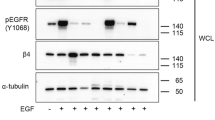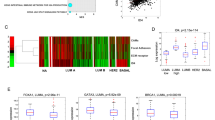Abstract
Overexpression of Integrin Linked Kinase (ILK) in intestinal and mammary epithelial cells results in a highly invasive phenotype, associated with increased levels of expression of the matrix metalloproteinase MMP-9. This increase was at the transcriptional level as determined by MMP-9 promoter-CAT reporter assays. Mutations in the two AP-1 binding sites within the MMP-9 promoter completely inhibited the reporter activity. We have previously shown that ILK inhibits glycogen synthase kinase-3 (GSK-3) activity. Transient transfection of wild-type GSK-3β in ILK-overexpressing cells decreased MMP-9 promoter activity and AP-1 activity, indicating that ILK can stimulate MMP-9 expression via GSK-3β and AP-1 transcription factor. A small molecule inhibitor of the ILK kinase reduced the in vitro invasiveness of ILK-overexpressing cells as well as the invasiveness of several human brain tumor cell lines. Furthermore, both MMP-9 promoter and AP-1 activities were inhibited by the ILK inhibitor. Invasiveness of ILK-overexpressing cells was also reduced by inhibition of MMP-9. These data demonstrate that ILK can induce an invasive phenotype via AP-1-dependent upregulation of MMP-9.
This is a preview of subscription content, access via your institution
Access options
Subscribe to this journal
Receive 50 print issues and online access
We are sorry, but there is no personal subscription option available for your country.
Buy this article
- Purchase on SpringerLink
- Instant access to full article PDF
Prices may be subject to local taxes which are calculated during checkout




Similar content being viewed by others
References
Dedhar S, Williams B and Hannigan G. . 1999 Trends Cell. Biol. 9: 319–323.
Delcommenne M, Tan C, Gray V, Ruel L, Woodgett J and Dedhar S. . 1998 Proc. Natl. Acad. Sci. USA 95: 11211–11216.
Gum R, Lengyel E, Juarez J, Chen JH, Sato H, Seiki M and Boyd D. . 1996 J. Biol. Chem. 271: 10672–10680.
Gum R, Wang H, Lengyel E, Juarez J and Boyd D. . 1997 Oncogene 14: 1481–1493.
Hannigan GE, Leung-Hagesteijn C, Fitz-Gibbon L, Coppolino MG, Radeva G, Filmus J, Bell JC and Dedhar S. . 1996 Nature 379: 91–96.
Janji B, Melchior C, Gouon V, Vallar L and Kieffer N. . 1999 Int. J. Cancer 83: 255–262.
Johnsen M, Lund LR, Romer J, Almholt K and Dano K. . 1998 Curr. Opin. Cell. Biol. 10: 667–671.
Kolkhorst V, Sturzebecher J and Wiederanders B. . 1998 J. Cancer Res. Clin. Oncol. 124: 598–606.
Liotta LA, Tryggvason K, Garbisa S, Hart I, Foltz CM and Shafie S. . 1980 Nature 284: 67–68.
Llorens A, Rodrigo I, Lopez-Barcons L, Gonzalez-Garrigues M, Lozano E, Vinyals A, Quintanilla M, Cano A and Fabra A. . 1998 Lab. Invest. 78: 1131–1142.
Luo J, Lubaroff DM and Hendrix MJC. . 1999 Cancer Res. 59: 3552–3556.
Mira E, Manes S, Lacalle RA, Marquez G and Martinez-A C. . 1999 Endocrinology 140: 1657–1664.
Morimoto AM, Tomlinson MG, Nakatani K, Bolen JB, Roth RA and Herbst R. . 2000 Oncogene 19: 200–209.
Mosmann T. . 1983 J. Immunol. Methods 65: 55–63.
Murphy G, Ward R, Hembry RM, Reynolds JJ, Kuhn K and Tryggvason K. . 1989 Biochem. J. 258: 463–472.
Novak A, Hsu SC, Leung-Hagesteijn C, Radeva G, Papkoff J, Montesano R, Roskelley C, Grosschedl R and Dedhar S. . 1998 Proc. Natl. Acad. Sci. USA 95: 4374–4379.
Ozes ON, Mayo LD, Gustin JA, Pfeffer SR, Pfeffer M and Donner DB. . 1999 Nature 401: 82–85.
Persad S, Attwell S, Gray V, Delcommenne M, Troussard A, Sanghera J and Dedhar S. . 2000 Proc. Natl. Acad. Sci. USA 97: 3207–3212.
Radeva G, Petrocelli T, Behrend E, Leung-Hagesteijn C, Filmus J, Slingerland J and Dedhar S. . 1997 J. Biol. Chem. 272: 13937–13944.
Romashkova JA and Makarov SS. . 1999 Nature 401: 86–90.
Rao JS, Steck PA, Tofilon P, Boyd D, Ali-Osman F, Stetler-Stevenson WG, Liotta LA and Sawaya R. . 1994 J. Neurooncol. 18: 129–138.
Sato F, Shimada Y, Watanabe G, Uchida S, Makino T and Imamura M. . 1999 Br. J. Cancer 80: 1366–1372.
Sato H and Seiki M. . 1993 Oncogene 8: 395–405.
Simon C, Goepfert H and Boyd D. . 1998 Cancer Res. 58: 1135–1139.
Tamaki M, McDonald W, Amberger VR, Moore E and Del Maestro RF. . 1997 J. Neurosurg. 87: 602–609.
Tonn JC, Kerkau S, Hanke A, Bouterfa H, Mueller JG, Wagner S, Vince GH and Roosen K. . 1999 Int. J. Cancer 80: 764–772.
Troussard AA, Tan C, Yoganathan TN and Dedhar S. . 1999 Mol. Cell. Biol. 19: 7420–7427.
Wang Q, Somwar R, Bilan PJ, Liu Z, Jin J, Woodgett JR and Klip A. . 1999 Mol. Cell. Biol. 19: 4008–4018.
Westermarck J and Kahari VM. . 1999 FASEB J. 13: 781–792.
Woessner JF. . 1991 FASEB J. 5: 2145–2154.
Wu C, Keightley SY, Leung-Hagesteijn C, Radeva G, Coppolino M, Goicoechea S, McDonald JA and Dedhar S. . 1998 J. Biol. Chem. 273: 528–536.
Acknowledgements
We thank Gerry Krystal (British Columbia Cancer Agency, Canada) for constructing the MSCV-ILK-V5 vector, Douglas Boyd (University of Texas, USA) for the MMP-9 promoter plasmids, Christopher Overall (University of British Columbia, Canada) for the MMP inhibitor, and Warren McDonald and Rolando Del Maestro (Brain Research Laboratories, University of Western Ontario, Canada) for carrying out the brain tumor invasion assays. This work was supported by grants from the National Cancer Institute of Canada (NCIC) to S Dedhar and the Canadian Breast Cancer Research Initiative (CBCRI) to CD Roskelley.
Author information
Authors and Affiliations
Rights and permissions
About this article
Cite this article
Troussard, A., Costello, P., Yoganathan, T. et al. The integrin linked kinase (ILK) induces an invasive phenotype via AP-1 transcription factor-dependent upregulation of matrix metalloproteinase 9 (MMP-9). Oncogene 19, 5444–5452 (2000). https://doi.org/10.1038/sj.onc.1203928
Received:
Revised:
Accepted:
Published:
Issue Date:
DOI: https://doi.org/10.1038/sj.onc.1203928
Keywords
This article is cited by
-
_targeting the ILK/YAP axis by LFG-500 blocks epithelial–mesenchymal transition and metastasis
Acta Pharmacologica Sinica (2021)
-
Overexpressed miR-200a promotes bladder cancer invasion through direct regulating Dicer/miR-16/JNK2/MMP-2 axis
Oncogene (2020)
-
Acetyl-L-Carnitine Prevents Methamphetamine-Induced Structural Damage on Endothelial Cells via ILK-Related MMP-9 Activity
Molecular Neurobiology (2016)
-
Regulatory effects of ΔFosB on proliferation and apoptosis of MCF-7 breast cancer cells
Tumor Biology (2016)
-
Integral membrane protease fibroblast activation protein sensitizes fibrosarcoma to chemotherapy and alters cell death mechanisms
Apoptosis (2015)



